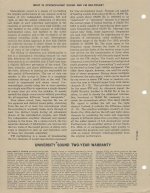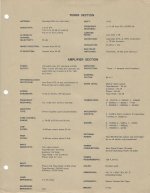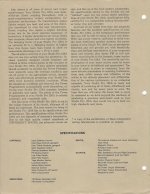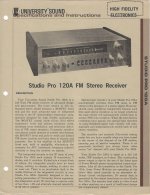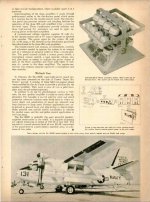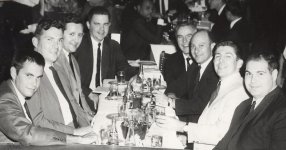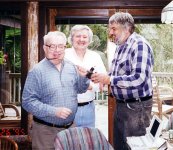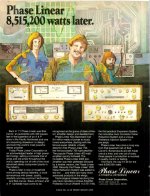Code:
I am hoping that I could get some help on a starting point on this amplifier.
I have this vintage receiver. It has A LOT of sentiments value to me.
However this amp doesn’t have a lot of support. I can’t even find the electrical schematic for it.
What it is
University Sound ( A Division of LTV Ling Altec. Inc) Studio Pro 120A
From I am guessing the 60s- 70s
I would like to restore it, or even improve it if it is possible.
The other modification I would like to make is wire in some preamp out Main in Jumpers so in the future I could use this for my preamp for my Dynakit St-70
So the question is where would I start?
- Can someone help me identified which each board is for?
- I am guessing all the capacitors need to be replaced at this point in its life.
What kind of capacitors can i use to replace them?
- Identification of where I could source out pre amp signals?
Thank you for your help!
Pictures will follow soon
All I could find on this 1970,s receiver was the manual-
https://products.electrovoice.com/binary/Studio Pro 120 Manual.pdf
LTV went bankrupt in 2000 .
Best of luck finding a schematic.
https://products.electrovoice.com/binary/Studio Pro 120 Manual.pdf
LTV went bankrupt in 2000 .
Best of luck finding a schematic.
Film & disk caps don't deteriorate. Rubber sealed water filled electrolytic caps do, the rubber age cracks and they dry out. Electrolytics have a plus on one end, a red end for plus, or a minus in balls on the other lead. NP after the voltage means non-polar electrolytic.
If you're in North America, you won't find much junk electrolytic capacitors at Newark, Digikey, Mouser. Caveat, they do sell 1000 hour service life capacitors for shops that want the customer back next year. Buy 3000 hours up service life capacitors if you don't like doing this job. Digikey and newark will put the service life in the selector table if your ask for it. Mouser makes you download & read the datasheet. Don't use newark in Canada if you don't want a $20 UPS loan origination fee.
Standard values have changed since 1970. No more 25, 50, 75. Replaced by 22, 33, 47, 51, 68. Round up in most cases except for timing & filter circuits.
Small ecaps fail first. .5, 1 &2 are particularly prone. Use polypro film caps for these, also 5 & 10.
Mark the plus on the board before removing, backwards caps blow their tops. Wear safety glasses, solder splashes. Do 2 at a time and test, amateurs make a lot of mistakes. If you did 2 & it gets worse, you know just where the problem is.
Special audio grade lines are IMHO a gilded pig. The long life industrial grades from Panasonic, nichicon, rubicon, vishay, multicomp have worked fine in my amps & organs. About 400 installed since I quit working in 2008.
If you're in North America, you won't find much junk electrolytic capacitors at Newark, Digikey, Mouser. Caveat, they do sell 1000 hour service life capacitors for shops that want the customer back next year. Buy 3000 hours up service life capacitors if you don't like doing this job. Digikey and newark will put the service life in the selector table if your ask for it. Mouser makes you download & read the datasheet. Don't use newark in Canada if you don't want a $20 UPS loan origination fee.
Standard values have changed since 1970. No more 25, 50, 75. Replaced by 22, 33, 47, 51, 68. Round up in most cases except for timing & filter circuits.
Small ecaps fail first. .5, 1 &2 are particularly prone. Use polypro film caps for these, also 5 & 10.
Mark the plus on the board before removing, backwards caps blow their tops. Wear safety glasses, solder splashes. Do 2 at a time and test, amateurs make a lot of mistakes. If you did 2 & it gets worse, you know just where the problem is.
Special audio grade lines are IMHO a gilded pig. The long life industrial grades from Panasonic, nichicon, rubicon, vishay, multicomp have worked fine in my amps & organs. About 400 installed since I quit working in 2008.
Last edited:
The University Sound “Studio Pro 120A” FM stereo receiver was designed by A.P. Van Meter.
NOTE: The comments made by me below are to the best of my memory and some in part due to conversations I had with A.P. Van Meter a number of years ago. I apologize in advance for any errors I may have made.
A.P. Van Meter obtained his MSEE in 1961 from the University of Oklahoma. During his education at the University of Oklahoma (1957-1961), A.P. spent his summer months working at a hi-fi store. This store also sold McIntosh audio equipment and the owner asked if he would be interested in a job at McIntosh and A.P. said something to the effect of: “you must be kidding”. The owner said he wasn’t kidding. Frank McIntosh came down and flew A.P. and his wife Mary back to Binghamton, N.Y. whereupon A.P. accepted the job and stayed there until 1965 or so. NOTE: 1962 was at about the time when FM began broadcasting in stereo and this was something A.P. had been studying in college. According to what I have found on the internet, A.P. worked on such products as the MX110 tuner/preamp, MA230 integrated amp, and MI3 stereo oscilloscope.
A.P. moved back to Oklahoma in approximately 1965 and began working for University Sound. The Studio Pro 120A was originally released as the Studio Pro 120 in late 1967 and was University Sound’s first receiver. (NOTE: A.P. was also named: “acting engineering manager at University Sound” in late 1967.) The Studio Pro 120 was in production throughout 1968. In 1969, the Studio Pro 120A was released. It appears to have been in production through 1970. Numerous ads for this receiver appeared in: Audio, Hi-Fi Stereo Review, High Fidelity and Stereo Review magazines. A.P. also told me an interesting story about was referred to as the “B.S. Bomber” that University Sound was involved with during the Vietnam war. An article on this “bomber” appeared in Electronics World September 1968 issue: “Super Sound System” (see page 38 forward).
In approximately 1974, A.P. began working for Phase Linear until the spring of 1983 when the design work on the Phase Linear 9500 CD player was completed and all operations had by then been moved to Laredo Texas. (NOTE: Phase Linear was sold to Pioneer in 1978 and subsequently to Jensen in either late 1981 or early 1982. Jensen shut the factory down in Lynnwood Washington in December 1982) While at Phase Linear, A.P. also worked on a number of products including the 5000 tuner and 6000 digital delay. A.P. became chief design engineer at Phase Linear after Bob Carver’s departure in early 1978.
NOTE: Sometimes the best or only way to determine someone’s involvement with a given product is to see if that person’s name appears on the schematics located in the service manuals. This may well be the case for A.P.’s involvement with McIntosh as well as Phase Linear. Many service manuals are available for free through the “Library” on hifiengine.com.
In my postings which will follow (below) are scans of some reviews, advertisements and a Studio Pro 120A sales brochure. A number of these advertisements appeared in a variety of magazines. I have chosen the best of each one that I could find.
Credit must be given to David Gleason, the owner of worldradiohistory.com (formerly americanradiohistory.com) for the majority of the magazine scans as well as Roger Russells website: roger-russell.com for the McIntosh photos.
A.P. Van Meter has an account on LinkedIn and also Facebook. He currently resides in Edmonds, WA.
NOTE: I don’t have an account on LinkedIn. Otherwise, I might have been able to verify some of the dates I have noted above.
Ed
NOTE: The comments made by me below are to the best of my memory and some in part due to conversations I had with A.P. Van Meter a number of years ago. I apologize in advance for any errors I may have made.
A.P. Van Meter obtained his MSEE in 1961 from the University of Oklahoma. During his education at the University of Oklahoma (1957-1961), A.P. spent his summer months working at a hi-fi store. This store also sold McIntosh audio equipment and the owner asked if he would be interested in a job at McIntosh and A.P. said something to the effect of: “you must be kidding”. The owner said he wasn’t kidding. Frank McIntosh came down and flew A.P. and his wife Mary back to Binghamton, N.Y. whereupon A.P. accepted the job and stayed there until 1965 or so. NOTE: 1962 was at about the time when FM began broadcasting in stereo and this was something A.P. had been studying in college. According to what I have found on the internet, A.P. worked on such products as the MX110 tuner/preamp, MA230 integrated amp, and MI3 stereo oscilloscope.
A.P. moved back to Oklahoma in approximately 1965 and began working for University Sound. The Studio Pro 120A was originally released as the Studio Pro 120 in late 1967 and was University Sound’s first receiver. (NOTE: A.P. was also named: “acting engineering manager at University Sound” in late 1967.) The Studio Pro 120 was in production throughout 1968. In 1969, the Studio Pro 120A was released. It appears to have been in production through 1970. Numerous ads for this receiver appeared in: Audio, Hi-Fi Stereo Review, High Fidelity and Stereo Review magazines. A.P. also told me an interesting story about was referred to as the “B.S. Bomber” that University Sound was involved with during the Vietnam war. An article on this “bomber” appeared in Electronics World September 1968 issue: “Super Sound System” (see page 38 forward).
In approximately 1974, A.P. began working for Phase Linear until the spring of 1983 when the design work on the Phase Linear 9500 CD player was completed and all operations had by then been moved to Laredo Texas. (NOTE: Phase Linear was sold to Pioneer in 1978 and subsequently to Jensen in either late 1981 or early 1982. Jensen shut the factory down in Lynnwood Washington in December 1982) While at Phase Linear, A.P. also worked on a number of products including the 5000 tuner and 6000 digital delay. A.P. became chief design engineer at Phase Linear after Bob Carver’s departure in early 1978.
NOTE: Sometimes the best or only way to determine someone’s involvement with a given product is to see if that person’s name appears on the schematics located in the service manuals. This may well be the case for A.P.’s involvement with McIntosh as well as Phase Linear. Many service manuals are available for free through the “Library” on hifiengine.com.
In my postings which will follow (below) are scans of some reviews, advertisements and a Studio Pro 120A sales brochure. A number of these advertisements appeared in a variety of magazines. I have chosen the best of each one that I could find.
Credit must be given to David Gleason, the owner of worldradiohistory.com (formerly americanradiohistory.com) for the majority of the magazine scans as well as Roger Russells website: roger-russell.com for the McIntosh photos.
A.P. Van Meter has an account on LinkedIn and also Facebook. He currently resides in Edmonds, WA.
NOTE: I don’t have an account on LinkedIn. Otherwise, I might have been able to verify some of the dates I have noted above.
Ed
Attachments
-
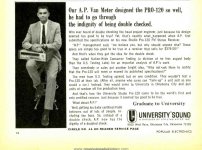 aa_Poptronics-1968-10 pg14.JPG268.1 KB · Views: 154
aa_Poptronics-1968-10 pg14.JPG268.1 KB · Views: 154 -
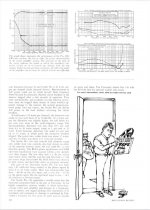 HiFi-Stereo-Review-1968-02 pg42.JPG171.3 KB · Views: 117
HiFi-Stereo-Review-1968-02 pg42.JPG171.3 KB · Views: 117 -
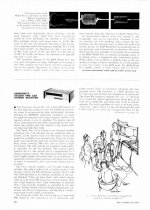 HiFi-Stereo-Review-1968-02 pg40.JPG182.4 KB · Views: 107
HiFi-Stereo-Review-1968-02 pg40.JPG182.4 KB · Views: 107 -
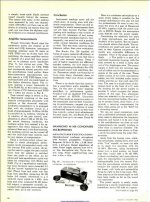 Audio-1968-01 pg46.JPG276 KB · Views: 97
Audio-1968-01 pg46.JPG276 KB · Views: 97 -
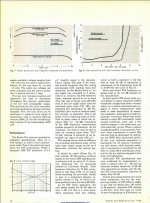 Audio-1968-01 pg44.JPG214.7 KB · Views: 135
Audio-1968-01 pg44.JPG214.7 KB · Views: 135 -
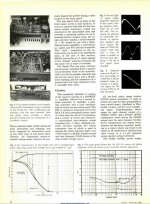 Audio-1968-01 pg42.JPG213.7 KB · Views: 131
Audio-1968-01 pg42.JPG213.7 KB · Views: 131 -
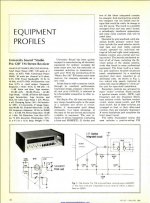 Audio-1968-01 pg40.JPG187.7 KB · Views: 156
Audio-1968-01 pg40.JPG187.7 KB · Views: 156 -
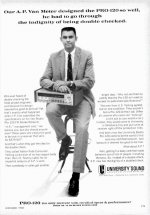 a_HiFi-Stereo-Review-1968-12 pg171 AP photo.JPG137.4 KB · Views: 177
a_HiFi-Stereo-Review-1968-12 pg171 AP photo.JPG137.4 KB · Views: 177
Here are some University Sound "Studio Pro 120" advertisements which appeared between 12/1967-12/1968.
As well as some University Sound "Studio Pro 120A" related ads which appeared in 1969.
As well as some University Sound "Studio Pro 120A" related ads which appeared in 1969.
Attachments
-
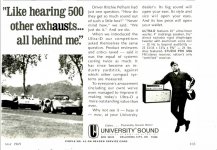 a_HiFi-Stereo-Review-1969-05 pg103 BEST.JPG265.5 KB · Views: 92
a_HiFi-Stereo-Review-1969-05 pg103 BEST.JPG265.5 KB · Views: 92 -
 a_ Audio-1969-03 pg67 BEST.JPG176.1 KB · Views: 74
a_ Audio-1969-03 pg67 BEST.JPG176.1 KB · Views: 74 -
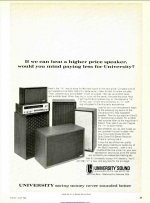 a_Audio-1968-05 pg39.JPG124.8 KB · Views: 92
a_Audio-1968-05 pg39.JPG124.8 KB · Views: 92 -
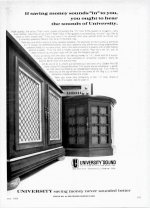 a_HiFi-Stereo-Review-1968-05 pg107.JPG153.5 KB · Views: 91
a_HiFi-Stereo-Review-1968-05 pg107.JPG153.5 KB · Views: 91 -
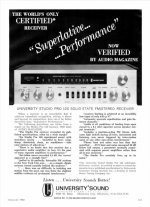 a_HiFi-Stereo-Review-1968-02 pg121.JPG173.5 KB · Views: 94
a_HiFi-Stereo-Review-1968-02 pg121.JPG173.5 KB · Views: 94 -
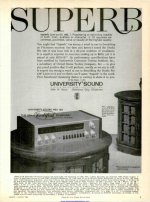 a_Audio-1968-03 pg5.JPG170.8 KB · Views: 95
a_Audio-1968-03 pg5.JPG170.8 KB · Views: 95 -
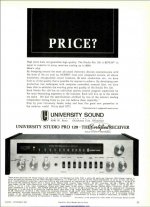 a_Audio-1967-12 pg35.JPG156.6 KB · Views: 106
a_Audio-1967-12 pg35.JPG156.6 KB · Views: 106 -
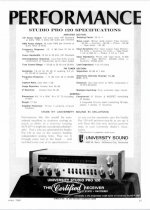 a_ HiFi-Stereo-Review-1968-04 pg15.JPG156.6 KB · Views: 95
a_ HiFi-Stereo-Review-1968-04 pg15.JPG156.6 KB · Views: 95 -
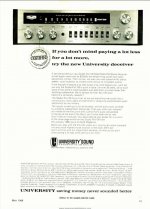 a_High-Fidelity-1968-05 pg11.JPG147.2 KB · Views: 93
a_High-Fidelity-1968-05 pg11.JPG147.2 KB · Views: 93 -
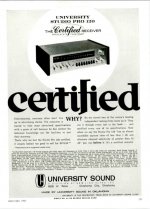 HiFi-Stereo-Review-1967-12 pg151.JPG150 KB · Views: 93
HiFi-Stereo-Review-1967-12 pg151.JPG150 KB · Views: 93
Here is the University Sound "Super Sound System" (a.k.a. "BS Bomber") article I mentioned in an earlier post.
It is also available at https://worldradiohistory.com/Archive-Electronics-World/60s/1968/Electronics-World-1968-09.pdf (see pages 38 and 39)
It is also available at https://worldradiohistory.com/Archive-Electronics-World/60s/1968/Electronics-World-1968-09.pdf (see pages 38 and 39)
Attachments
Here are a couple of photos obtained from Roger Russell's web site. The black and white photo has the following comments from Roger:
"In 1967, a few of us were able to accept Gordon Gow’s invitation to go to the Latin Quarter in New York City for the evening. This included (left to right) A.P. Van Meter (an engineer who used to work at McIntosh), Sidney Corderman (Vice President of Engineering and my boss), Mila Nestorvic (engineer), me (engineer), Gordon Gow (Executive Vice President), Fred Shoninger (dealer), unknown, and Jim Grimm (engineer)."
The second photo was also obtained from Roger Russell's website concerning Dave O'Brien (who conducted the McIntosh clinics for many years):
"He also made many annual trips to visit his friends, the Van Meters, out in the state of Washington. He titled this picture as “Three Grumpy Old Men.” Left to right are Dave, Mila Nestorvic and AP Van Meter."
"In 1967, a few of us were able to accept Gordon Gow’s invitation to go to the Latin Quarter in New York City for the evening. This included (left to right) A.P. Van Meter (an engineer who used to work at McIntosh), Sidney Corderman (Vice President of Engineering and my boss), Mila Nestorvic (engineer), me (engineer), Gordon Gow (Executive Vice President), Fred Shoninger (dealer), unknown, and Jim Grimm (engineer)."
The second photo was also obtained from Roger Russell's website concerning Dave O'Brien (who conducted the McIntosh clinics for many years):
"He also made many annual trips to visit his friends, the Van Meters, out in the state of Washington. He titled this picture as “Three Grumpy Old Men.” Left to right are Dave, Mila Nestorvic and AP Van Meter."
Attachments
In 1976 Phase Linear took out an ad in Audio, High Fidelity, Popular Electronics and Stereo Review.
The ad stated: "Phase Linear 8,515,200 watts later"
The ad mentions Bob Carver, Steve Johnston (Bob's partner) and A.P. Van Meter.
The ad stated: "Phase Linear 8,515,200 watts later"
The ad mentions Bob Carver, Steve Johnston (Bob's partner) and A.P. Van Meter.
Attachments
I am just getting back to this project. I made a list of all the capacitors and wanted to share/document this somewhere if anyone else wants to restore one of these receivers
| Location | Capacitence | Voltage | Polar/Non Polar |
| Filter Capacitor | 4700 uf | 75 | Polar |
| Main Cap | 4000 uf | 30 | Polar |
| Main Cap | 4000 uf | 30 | Polar |
| PS | 50 uf | 25 | Polar |
| PS | 400 uf | 16 | Polar |
| PS | 400 uf | 16 | polar |
| PS | 32 uf | 64 | polar |
| PS | 50 uf | 25 | polar |
| PS | 50 uf | 25 | polar |
| PS | 50 uf | 25 | polar |
| PS | 400 uf | 16 | polar |
| Signal | 10 uf | 25 | polar |
| Signal | 10 uf | 25 | polar |
| Signal | 10 uf | 25 | polar |
| Signal | 10 uf | 25 | polar |
| Signal | 10 uf | 25 | polar |
| Signal | 10 uf | 25 | polar |
| Signal | 50 / | 6.4 | polar |
| Signal | 50 / | 6.4 | polar |
| Signal | 5 / | 64 | polar |
| Signal | 5 / | 64 | polar |
| Signal | 50 / | 6.4 | polar |
| Signal | 50 / | 6.4 | polar |
| Signal | 10 mfd | 25 | polar |
| Signal | 10 mfd | 25 | polar |
| Signal | 10 mfd | 25 | polar |
| Signal | 10 mfd | 25 | polar |
| Signal | 10 mfd | 25 | polar |
| Signal | 10 mfd | 25 | polar |
| Signal | 50 uf | 25 | polar |
| Signal | 50 uf | 25 | polar |
| Signal | 50 uf | 25 | polar |
| Signal | 50 uf | 25 | polar |
Last edited:
- Home
- Amplifiers
- Solid State
- Studio Pro 120A Vintage amp restore
